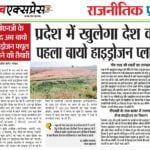Bamboo takes four years to grow without yield, but then provides a fixed annual income for 90 years.
The high consumption of carbon dioxide and the high release of oxygen and the ability to make the soil fertile are unique advantages of bamboo and its use has been known and well documented for centuries. Due to the fact that it is a wild plant under the forest department, its cultivation in the state is not possible.
However, the situation has now changed as central and state governments push for bamboo cultivation. Madhya Pradesh recently created a horticulture department as the main department instead of a forestry department so that people could legally grow bamboo. An order was issued after government approval. The Horticultural Commissioner is the mission director of the State Bamboo Mission.
In addition, bamboo growers receive a 60 percent subsidy under the National Bamboo Mission. The State Agricultural Mission of Andhra Pradesh (APSAM) has taken the initiative to bring bamboo into horticulture so that farmers can grow it as an alternative crop on part of their land and increase their income.
In an interview with TNIE, APSAM MVS Vice President Nagi Reddy explained that many crops are grown in the state and some of them, such as rice, are being grown, which can only be counterproductive for farmers. “We are exploring alternatives, especially in the borehole regions, supporting millet, pulses and horticultural crops. In our study, we found that bamboo is a good alternative, “he said.
The alternative does not mean that the whole plant (whatever it is) is replaced by bamboo, but by cultivation in certain parts of the country, he explained. Farmers did not plant bamboo when it lay under the forest. It has already been transferred to the horticultural department, he said.
Bamboo takes four years to grow without yield, but then provides a fixed annual income for 90 years. A bamboo tree can produce shoots every time it grows on its own after the first care. “That doesn’t mean we have to grow and leave for a while. We have to take care of it like any other crop, for better yields,” Nagi Reddy said, adding that because it was a water-intensive crop, it was not suitable for semi-arid areas.
Asked if there was a bamboo market, APSAM vice president said there had been a large increase in the market. “There is a community called Medara (bamboo weavers) who make a living making bamboo products. Bamboo has always been an important part of our lives and culture. It is used for fencing plants, especially as a support for banana trees, for food and catches for aquaculture, it is used for various rituals of everyday life and even for the production of Agarbatti incense sticks, “he said.
As there is no bamboo in the state, it is imported from Assam and other northeastern states. An average of 150 to 200 bamboo trucks will come to the AP from such countries. An 18 foot long bamboo costs around 90 to 100 Rs. Currently, several farmers are growing bamboo in an experiment and the result is expected in a year or two.
Plan B for farmers to increase incomes
After four years, it provides a steady annual income for 90 years
As part of the National Bamboo Mission, farmers receive a 60 percent subsidy





